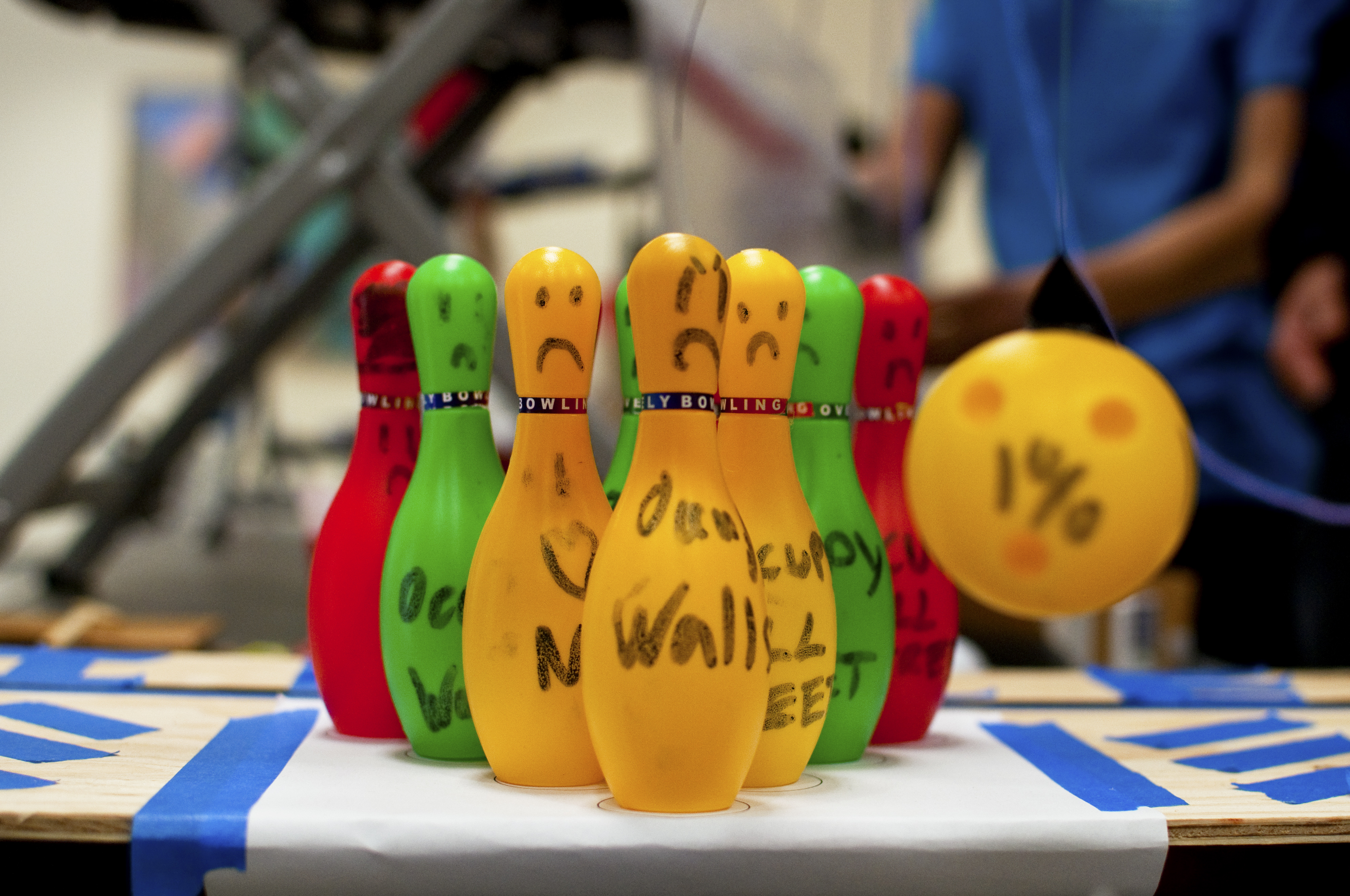
During the recent Rube Goldberg competition at UCLA, competitors had to build a machine that, in whatever way conceivable, was able to knock over a set of bowling pins.
Clarification: One of the original photo captions was misleading. Though the Officers from IEEE did, in fact, win the competition, the people pictured are members of Team Kitten Cannon, which took second place.
A golf ball tumbled down a chute and plunked onto the plastic seat of a chair.
One by one, dollar-store items fell into the convoluted, tightly choreographed dance of a Rube Goldberg machine. A hot pink figurine parachuted to the floor, a clump of Play-Doh dropped into a cup and a line of dominoes toppled over.
Then a ball swung through the air, upending 10 miniature bowling pins. Strike!
Officers from the UCLA Institute of Electrical and Electronics Engineers, who had constructed the contraption, yelled excitedly and hugged one another. After three hours of building and two test runs, they nabbed first place at the Rube Goldberg competition hosted by UCLA engineering honors society Tau Beta Pi on Saturday.
Theirs was the only machine to run without a glitch on the initial attempt.
“I was really nervous ““ if one thing goes wrong, the whole thing doesn’t work,” said Siddarth Rao, a third-year electrical engineering student on the team.
A Rube Goldberg machine ““ named after the inventor and Pulitzer-Prize winning cartoonist ““ performs a simple task in an elaborate sequence of steps.
During the competition, teams had to find a way, however absurd, to knock over a set of bowling pins.
Their contraptions delighted in yoking together opposites: the technical and the whimsical, celebrating the laws of physics and trying to manipulate them.
Whereas engineering disciplines usually focus on finding one optimal solution, Rube Goldberg machines require inventive and open thinking, said Shawn Senior, a UCLA alumnus and engineer at the company Lockheed Martin, which sponsored the competition.
“As an engineer, usually you’re designing something that’s efficient,” said Ian McRae, a third-year chemical engineering student. “This is nearly the reverse.”
Teams at the second annual competition had between five and eight students, most of them engineers. They received boxes full of household materials: coffee filters, hula hoops, fly swatters, plastic cars, balloons, clothespins.
Students cobbled together the different pieces in a process defined by trial, error and lots of tweaking.
Nearly all the machines had some flaw, including that of the second-place group, Team Kitten Cannon.
With 21 minutes left on the clock, Team Kitten Cannon ““ named after an online computer game ““ rehearsed their machine.
Cries of “Do it!” and “No touching!” emerged as they prepared for the moment of truth.
The centerpiece was what team members called a “triple waterfall.” A red plastic cup of water would be tipped over, spilling its contents into a tier of three cups.
The idea was that the last cup would collect the water and act as a weight to collapse a chair. Scissors would snap shut, cleaving through a length of yarn and releasing a lever, which would then release a ball toward the bowling pins.
But the machine stalled after the waterfall, and time ran out before the team could find a fix.
In building their contraptions, the minds of the competitors traveled in diverse directions: some looked to the days when they built with Legos and K’NEX, some thought about tapping into energy effectively and others just maintained a good sense of humor.
“We didn’t take ourselves too seriously,” said fourth-year mathematics student Marc Bauthier, who competed with his friends in Team Yogi. “We didn’t come here to win, we came to play.”
Bonus points were awarded for completing certain tasks, such as addressing social topics or floating a vessel across water.
The winning team built their machine around the issue of income inequality. The team marked its bowling pins as the 99 percent, while the ball that knocked them over represented the highest earners.
“The machine is about how the machinations of the 1 percent are going to affect the 99 percent,” said fourth-year electrical engineering student Leo Szeto.
Chi Shing Tsui, a fourth-year chemical engineering student, thought back to his teenage years. He had wanted to be able to turn the lights off while sitting in bed, and imagined he could put up a rail that would lead to the light switch. Drop a ball down the ramp, and seconds later, the room will go dark.
“But my parents wouldn’t let me,” he said.
The machine Tsui’s team built included a channel, constructed from a long Styrofoam tube, that guided a rolling ball.
Third-year materials science and engineering student Philip DePond, meanwhile, drew inspiration from the movie “Back to the Future Part III.” In the film, electricity running through train tracks propels a car, DePond said.
He attached batteries and wires to a toy car, then had it drive into a mesh of aluminum foil. This would create a complete circuit and kick-start a motor.
“We’re using random things that are not supposed to fit together,” DePond said. “So we have to make them.”
